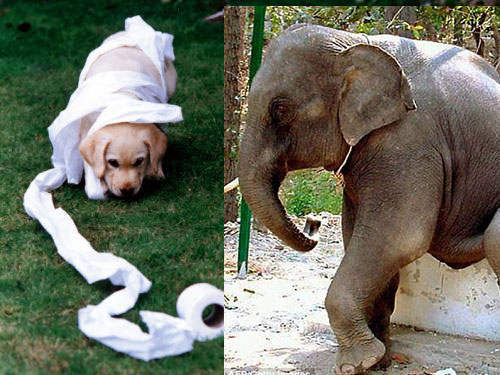Discovering the 'law of peeing' of animals
Scientists have discovered a very interesting thing: All mammals urinate within the same time period.
A study by Patricia Yang and colleagues at the Georgia Institute of Technology in Atlanta (USA) showed that mammals of different sizes, from elephants to mice, all take about 21 seconds. to urinate.
The team used videos to record the urination of animals in the zoo, combining them with data on volume, bladder pressure and urethral size so that conclusions could be reached. they called 'urination law'.

Elephants, dogs and other mammals all urinate in the same time
They can also create an animal's urinary system of mathematical models and develop a theory that explains why animals urinate at the same time.
Scientists have compared the urination time of large animals like elephants with smaller animals like dogs and goats. Elephants have large bladder but in return, they have long and wide urethra (with a diameter of about 10cm and a length of about 1m), meaning that urine can flow at a faster rate than small animals, flow rate flow also increased due to gravity. Meanwhile, small animals have a small bladder but the urethra is small, the flow is slower, so the urine slows down. As a result, small and large animals all need roughly the same time to empty their bladder.
Gravity plays a small role in urination in small animals like mice and bats. Instead, the viscosity and surface tension are the main contributors . This explains why small animals urinate into droplets rather than a continuous stream like in larger mammals.
Ms. Yang hopes the study of this urination law can help diagnose urinary diseases in other mammals and mammals. It even brings new inspiration to water tower and pump designs using gravity.
- The wrong thoughts in life that we still believe
- Great anti-hot moves are only available in animals
- Discovering the sunshine about
- Incredibly unique alien creatures
- Discovering new viruses that harm animals
- Discovering animals 'never before seen in life'
- Anatomical sight of a
- Video: Discovering the strange giant salamander in Japan
- People discovering DNA cause scandal about racism
- Discovering heavenly medicine: People can turn into plants or animals
- Discovering immortal animals on Earth
- Discovering the kingdom of gorillas in Africa
 Animal 'suffering' after hibernation
Animal 'suffering' after hibernation Why do goats climb well?
Why do goats climb well? Scientists were surprised to see chimpanzees eating turtles
Scientists were surprised to see chimpanzees eating turtles Giant catfish died deadly due to drought in Thailand
Giant catfish died deadly due to drought in Thailand